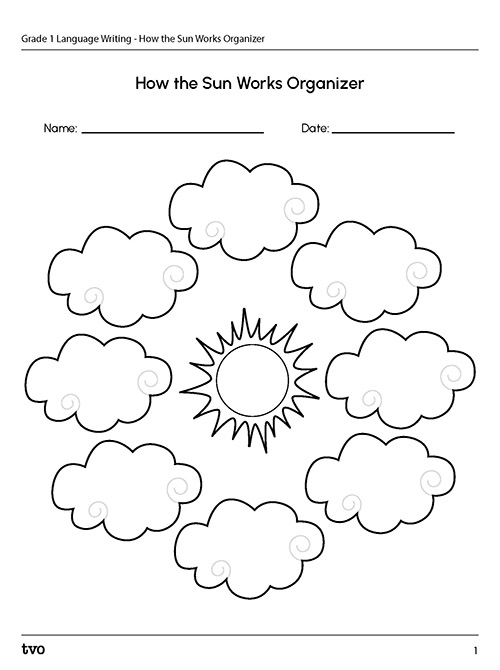Minds On
Sharing and explaining
Have you ever had to explain something to someone? What are some times when you explained something to someone?
Think back to what you said. How did you explain yourself so the other person understood?

Action
Explanatory writing
When we talk about how something is made, how something works or what it is, that is called explanatory writing.
Explanatory writing is different than telling someone how to do something like in a recipe. When we explain something to someone, we are teaching about the topic.
Let’s take a look at an example. We learn about how plants drink water.
In this video, Teacher Aldo explained how plants drink water.
We learn important facts like:
- a plant is made up of stem, leaf, flowers and roots
- plants drink water just like us
- special vessels called xylem vessels carry water from the ground to all the parts of the plant
- when a plant has enough to drink it stands up straight and tall
We can use this information to explain how plants drink to others. When we learn the facts and then write about those facts, that is called nonfiction writing.
Fiction and nonfiction
Two kinds of writing are fiction and nonfiction. An example of fiction writing is a narrative, or short story. An example of nonfiction writing is to explain how something works or is made. Think of examples of things you have read that are fiction and nonfiction.
How can you tell fiction writing from nonfiction writing? Is the plant video fiction or nonfiction?
In nonfiction writing, it is important to only write the facts.
What is a fact?
A fact is something that:
- is true
- is real information
- can be proven
Make sure your explanatory writing only has facts!
Discussion
What are some characteristics of fiction and nonfiction writing? How are the two types of writing different? Now, press the button ‘Fiction vs. Nonfiction’ to compare your ideas with the characteristics provided. Did you have ideas that need to be added to the list?

Fiction writing:
- read to enjoy
- sequence: beginning, middle and end
- elements: characters, setting, problem, solution
- stories are not true

Nonfiction writing:
- read to learn
- sequence: read in any order with subtitles and headings
- to organize information
- elements: photos, tables, charts,
- facts, keywords, diagrams
- information is true
How something is done, made, and works
In this learning activity, we are going to learn about how something is done, is made or how something works. The following are items and features of writing explanatory text:
- gathering facts
- organizing information
- opening – topic sentence
- three facts about the topic to explain how something works or is about
- end: topic repeated, “Now you know how…”
As we write, we follow the writing process.
Before going through the steps in the writing process, brainstorm ideas for your writing.
Prewriting: brainstorm
Gathering facts
How does the sun work to give us heat and light? Check out the following video to learn some facts about the sun.
Using what we learned from the video, choose at least 3 facts to record in the How the Sun Works Organizer in your notebook or use the page that is here to record your ideas.

Press the Activity button to access the How the Sun Works Organizer.
Activity (Open PDF in a new tab)Drafting: writing plan and draft
A writing plan helps to decide who your writing is for and what it is about.
Q: Who will read my writing?
A: My friends and teacher
Q: What am I writing about?
A: An event in our class
Q: What am I trying to do with my writing?
A: To inform
Q: How will I get my ideas out?
A: Sentences
Use the Explanatory Writing Graphic Organizer in your notebook or use the following fillable and printable document to begin writing a draft.

Press the Activity button to access the Explanatory Writing Graphic Organizer.
Activity (Open PDF in a new tab)Consolidation
Revising: focus on content
We have worked on two different writing activities. It is time to revise and then edit our first example, “How the Sun Works.”
When revising work, you want to:
- find other words you might want to use
- use strong transition words
- make other changes so the writing is just right
- stay on one topic
Explanatory checklist
Editing: focus on conventions
Editing Checklist
Student Success
Think-Pair-Share
If possible, share your work with a partner. Read your work out loud. What did you like? What do you still wonder about?

Note to teachers: See your teacher guide for collaboration tools, ideas and suggestions.
Publishing: share your work!
Turn your explanatory writing text into a media piece of your choice to share in your school. A media piece may be a poster, brochure, video collage or recorded oral presentation.
Include the following in your media piece:
- a title to make it interesting
- a topic sentence to tell the reader what the poster is about
- information about how the sun works to heat and light Earth (use your facts)
- an interesting wrap up
- “catchy” (use the publishing checklist)
Publishing Checklist
Have I:

Did I use:
Is my work:
Reflection
How do you feel about what you have learned in this activity? Which of the next four sentences best matches how you are feeling about your learning? Press the button that is beside this sentence.
I feel...
Now, record your ideas about your feelings using a voice recorder, speech-to-text, or writing tool.